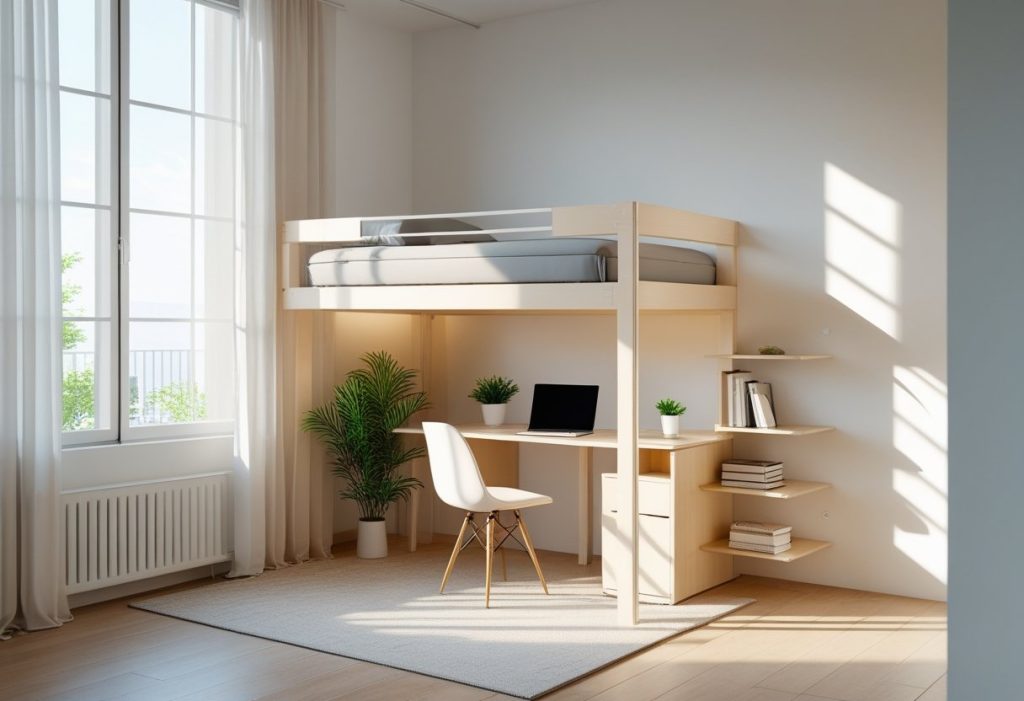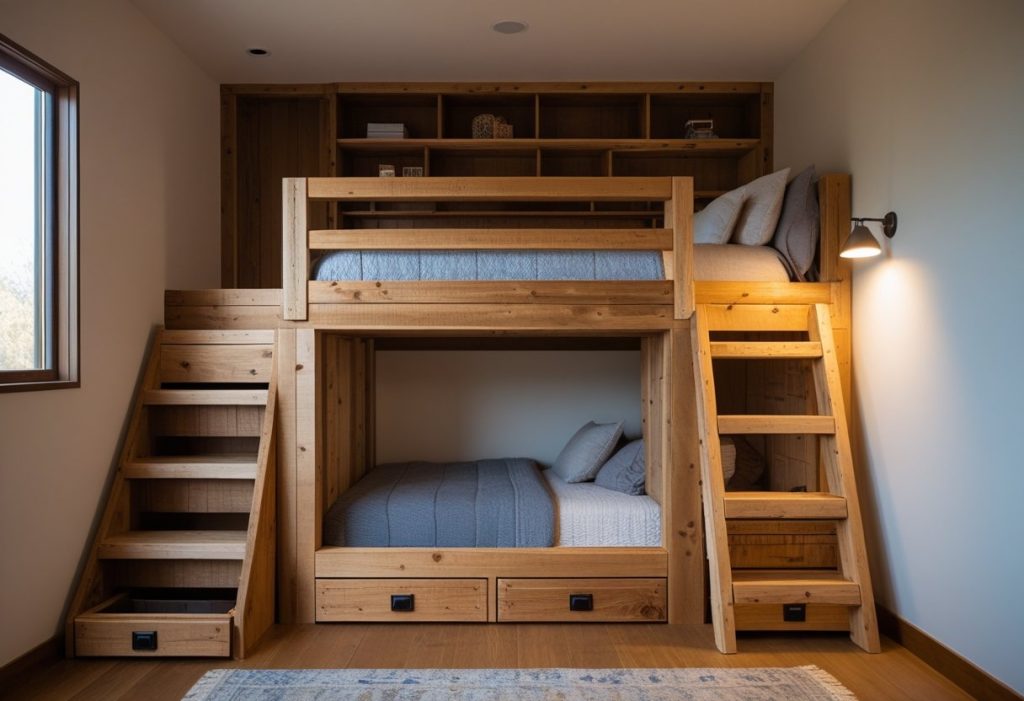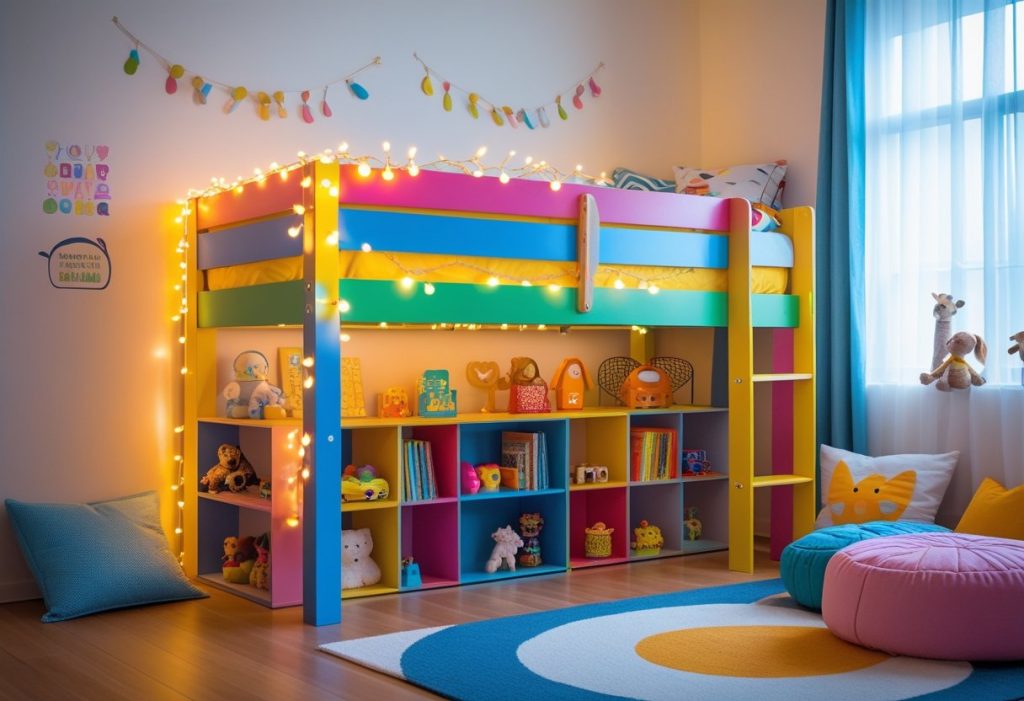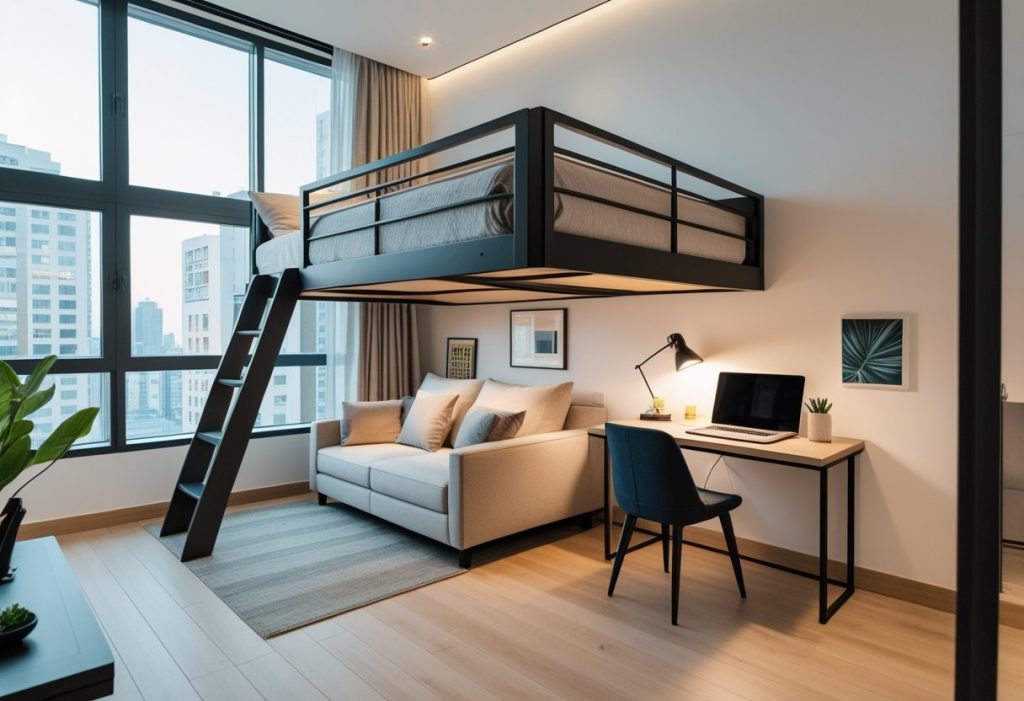A loft bed is a type of bed that is raised high off the ground, creating extra space underneath for other uses like storage, a desk, or play area. This design makes loft beds very popular in small rooms where maximizing space is important. They offer a practical solution for saving floor space without sacrificing sleeping comfort.
Loft beds come in different styles and materials, often made from wood or metal. Some include built-in shelves, drawers, or stairs with storage to keep the room organized. They work well for kids, teens, and even adults, depending on the size and features chosen.
Choosing the right loft bed depends on space needs, safety, and personal preferences. Many stores offer a wide range of options to suit different budgets and room designs, making it easy to find one that fits well.
Key Takeways
- Loft beds save floor space by raising the sleeping area.
- They come in various styles, sizes, and materials.
- Safety and room layout should guide the choice of loft bed.
- Read more about Fall HOME Decor Ideas.
What Is a Loft Bed?
A loft bed is a raised sleeping surface designed to save floor space. It differs from other bed types by lifting the mattress high enough to free up room underneath. This extra space can be used in several ways that make small rooms more practical and organized.
Definition and Differences From Bunk Beds
A loft bed is a single elevated bed with open space beneath it. Unlike a bunk bed, which has two beds stacked on top of each other, a loft bed only has the upper bed.
This design gives extra room below for furniture such as desks, dressers, or storage. Loft beds save space without needing a second sleeping area.
The main purpose is to use vertical space efficiently, which is often valuable in small bedrooms and dorms.

History and Evolution
Loft beds first became common in the late 20th century as urban living spaces shrank. They gained popularity in dormitories, apartments, and kids’ rooms.
Originally simple metal frames, loft beds evolved to include built-in desks, shelves, and storage compartments. Designs now range from basic frames to elaborate setups with stairs and safety rails.
Manufacturers have expanded loft beds to fit various mattress sizes, including twin, full, and even adult models.
Common Uses
Loft beds are popular in small apartments, dorm rooms, and kids’ bedrooms. They maximize floor space by freeing up an area under the bed for other uses.
Common uses for the space below a loft bed include:
- A desk for studying or work
- Storage shelves or wardrobes
- A seating or lounging area
This flexibility makes loft beds practical for people needing to organize limited space efficiently.
Types of Loft Beds
Loft beds come in different styles to suit various needs. Some offer just an elevated sleeping area, while others add desks or storage for better room use. There are also custom options for unique spaces or heavy use. For more room-saving and stylish ideas, explore our Living Room Decor category.
Standard Loft Beds
Standard Raised Bed raise the mattress off the ground on four posts, creating open space underneath. This free area can be used for seating, storage, or play.
These beds usually have a simple, sturdy frame made from wood or metal. Guardrails and ladders are common features for safety and access.
Standard Raised Bed work well for rooms that need more floor space without added furniture underneath. They are a good choice if the user wants flexibility in how they use the space below.
Loft Beds With Desks
Loft beds with desks include built-in workspaces beneath the raised bed. This setup maximizes small bedrooms by combining sleeping and study areas.
The desk space is integrated or attached to the frame. It may include shelves or organizers for books and supplies. This type suits students or anyone who needs a dedicated work area without taking up extra room.
These beds often feature full guardrails and durable ladder designs for safety. They help keep the bedroom neat by providing a specific spot for homework or projects.
Loft Beds With Storage
Some loft beds come with built-in storage such as drawers, shelves, or cabinets below the sleeping area. This design reduces the need for extra furniture in tight spaces.
Storage loft beds are practical for bedrooms with limited room for dressers or closets. They may include under-bed drawers or stacked cubbies.
This option is ideal for organizing clothes, toys, or other belongings. The added storage keeps the space tidy while making the most of vertical room.
Custom and Modular Loft Beds
Custom or modular loft beds offer flexible designs tailored to individual needs. They can include adjustable heights, added desks, stairs with storage, and other features.
These beds are often built from high-quality materials to support heavy use. Modular systems allow rearranging or adding components as needs change.
They suit adults or families who want a personalized sleeping and living area. Such beds may support larger mattress sizes and include options for durability and style.
Materials and Construction
Choosing the right materials affects the loft bed’s strength, appearance, and ease of building. Construction methods vary based on the material used and the intended use of the bed.
Wood Loft Beds
Wood is the most common material for loft beds because it combines strength with ease of work; popular choices include pine—affordable and lightweight but sometimes needing extra reinforcement—oak—durable and heavier for a sturdier frame—and plywood—often used for bed panels and stairs because of its flat, smooth surface. For practical buying and construction tips see the expert guide on The Spruce and detailed woodworking advice at Wood Magazine, and for related loft bed styling examples visit our internal guide on Loft Bed Ideas.
For construction, lumber sizes like 2x4s and 1x6s are standard for the frame. Nails and wood screws hold pieces together securely. Wood glue adds extra stability. Sanding and finishing the wood prevents splinters and helps it last longer.

Metal Loft Beds
Metal loft beds use steel or iron tubes and frames, offering strong support with less bulk. These beds are often lighter than wood and can include simple piping or welded joints. Metal frames are resistant to warping and insects, making them durable over time.
Assembly usually involves bolts, screws, and sometimes welding. Metal beds often come pre-cut for easier assembly. The finish, like powder coating, prevents rust and maintains the bed’s look. Metal loft beds suit modern designs and often include guardrails and ladders for safety.
Sustainable Materials
Using sustainable materials helps reduce environmental impact. Bamboo is a popular eco-friendly option because it grows quickly and is very strong. Reclaimed wood is also common, giving new life to old lumber while maintaining durability.
These materials may need more careful treatment to ensure safety and longevity. Non-toxic finishes and water-based sealants protect the wood without harmful chemicals. Sustainable choices can add unique styles and textures, fitting well in both rustic and modern rooms.
Safety Considerations
Loft beds need careful attention to safety features to prevent accidents. Key factors include how much weight the bed can hold, how secure the guard rails and ladder are, and how the bed is installed in the room.
Weight Capacity and Stability
The weight capacity of a loft bed is the maximum load it can safely hold. This includes the mattress, bedding, and the person or people using the bed. Users should check the manufacturer’s specifications before use.
A strong frame made of metal or solid wood improves stability. Beds that meet safety standards, like ASTM, are tested for durability and strength.
Even when a bed meets weight guidelines, some movement is normal but should not affect stability. If there is excessive wobbling, the bed may need tightening or additional support. Stability can be reduced by damaged parts or improper assembly.
Guard Rails and Ladder Design
Guard rails are essential to prevent falling, especially since loft beds sit high off the floor. They should be installed on all sides that are open and be tall enough to stop a person from rolling off during sleep.
A mattress must fit snugly within the frame to avoid gaps where a person could get stuck. The ladder should be sturdy with non-slip steps and secured firmly to the bed frame.
Many safety guidelines recommend guard rails to be at least 5 inches above the mattress top. Ladders designed with angled steps or handrails offer safer climbing and descending.
Installation Best Practices
Proper installation affects bed safety significantly. The bed should be assembled exactly according to the instructions. Using the correct tools and hardware supplied by the manufacturer is crucial.
The bed should be placed away from ceiling fans, windows, and heaters to avoid injury. Ceiling height must allow safe clearance above the bed, usually a minimum of 33 inches between mattress and ceiling.
Secure the bed to the wall if possible, especially in rooms prone to shaking or where many people use the bed. Regularly check all bolts and fastenings for tightness to maintain safety over time.
Space-Saving and Design Ideas
Loft beds create extra room by lifting the sleeping area off the ground. This use of vertical space opens up floors for other furniture or activities. Design choices can further enhance the bed’s function while making the room visually appealing.
Maximizing Small Rooms
In small rooms, loft beds free up floor space for desks, seating, or storage. Choosing a loft bed with built-in shelves or drawers increases storage without adding extra furniture. Placement matters; positioning the bed near a window can improve light and make the room feel bigger.
Using light-colored materials or minimalist frames prevents the bed from crowding the room. Open designs keep the space under the bed flexible for different needs. Those in very tight spaces sometimes opt for compact loft beds with integrated desks or wardrobes to fully use every square inch.
Multi-Functional Loft Bed Layouts
Loft beds often serve more than one purpose. Many designs pair the elevated bed with a desk, wardrobe, or seating area below. This creates a mini-room for work, study, or relaxation without needing additional furniture.
Choosing modular or adjustable parts allows the loft bed to change as needs evolve. For example, some beds convert from study space to play area, or from storage to guest seating. Multi-functional layouts suit children, teens, and adults, especially in studios or shared bedrooms.
Decor and Customization Tips
Decorating a loft bed can make it feel like a unique, personal space. Adding curtains or fabric panels under the bed creates privacy or a cozy nook. Using string lights or LED strips adds both light and ambiance safely.
Custom storage boxes, bins, or hooks attached to the frame improve organization. Painting or finishing the bed in a color that matches the room ties it into the overall design. For safety and style, choosing sturdy materials and smooth edges is important.
Choosing the Right Loft Bed
Choosing a loft bed involves checking the room size, who will use it, and what mattress fits best. Safety and comfort are key, along with space under the bed for extra furniture or storage.
Factors to Consider
The height of the loft bed affects headroom and room feel. Low lofts stand about 40-50 inches tall and work well for small spaces or kids. Taller lofts create more under-bed space but need higher ceilings.
Material and build quality matter. A strong frame made from solid wood or metal lasts longer and supports more weight. Look for sturdy guardrails and ladders to avoid falls.
Room layout influences the bed size and placement. Measure the room carefully, including the ceiling height, window location, and door swings. Some loft beds offer custom options like colors or built-in desks.
Selecting for Children vs. Adults
Children’s loft beds usually have lower heights and stronger safety features such as high guardrails and soft edges. They fit smaller mattresses like twin or full size.

Adults need loft beds with strong weight limits and more height for comfort. Many adult loft beds offer queen or full sizes and multi-use options like desks or sofas underneath.

For both kids and adults, easy-to-climb ladders or stairs are important. Adults might prefer stairs with railings, while kids might manage vertical ladders better.
Mattress Compatibility
Most Raised Bed fit standard mattress sizes: twin, full, or queen. It’s important to check the frame’s mattress size limit before buying.
The mattress thickness matters for safety and comfort. A mattress that’s too thick can reduce guardrail height and increase fall risk. Ideally, choose a mattress no thicker than 8-10 inches unless the loft bed’s guardrails are very high.
Firm mattresses work best to prevent sinking and maintain stability. Adjustable or foam mattresses may not always fit correctly depending on bed frame design.
Loft Bed Maintenance and Care
Proper care keeps a loft bed safe and lasting longer. Regular cleaning prevents dust buildup, while periodic checks catch loose bolts or damage early. Attention to these details ensures the bed stays stable and secure.
Cleaning and Upkeep
Dust and dirt can collect on the frame and mattress, weakening materials over time. Using a soft cloth or vacuum with a brush attachment helps remove dust from hard-to-reach places like corners and slats.
Wiping down metal or wooden parts with a damp cloth and mild cleaner prevents grime buildup. Avoid soaking wood to protect its finish and avoid rust on metal parts by drying surfaces thoroughly.
Mattress care is also important. Regularly flipping or rotating the mattress extends its lifespan. Washing bedding often keeps the sleeping area clean and hygienic.
Inspection and Repairs
Checking the bolts and screws every few months is key. Tighten any that feel loose to keep the bed stable. Loose fittings can cause wobbling or safety risks.
Look for cracks in the wood or bent metal parts. These signs mean the bed could weaken and might need professional repair or replacement.
If the bed includes guardrails or ladders, inspect them closely for secure fastening. Replace any worn-out hardware or damaged components immediately to avoid accidents.
Where to Buy Loft Beds
Loft beds are available from several sources with different benefits. Some sellers offer a wide variety online, while others provide hands-on shopping at local stores. Custom builders can also make Raised Bed tailored to specific needs and spaces.
Online Retailers
Online retailers have large selections of Raised Bed in various styles and price ranges. Sites like Amazon, Walmart, and Wayfair often provide detailed product descriptions and customer reviews. Many offer features such as built-in desks, storage options, or USB ports.
Free shipping is common on orders over a certain amount, and some stores allow in-store pickup. Shoppers can compare prices quickly and see multiple brands in one place. Delivery times vary, so checking return policies is important before buying.
Local Furniture Stores
Buying a loft bed from a nearby furniture store lets buyers see the product before purchasing. Stores like IKEA, Lowe’s, or The Home Depot carry models for kids, teens, and adults. Customers can often test the bed’s stability and finish.
Many stores offer assembly services or delivery for an extra fee. Staff can answer questions about sizing or compatibility with mattresses. Local stores may also feature special sales or clearance options for better deals.
Custom Builders
Custom builders make loft beds tailored to exact room measurements and style preferences. This option suits those with unusual room layouts or specific design ideas. Custom beds often include unique features like built-in shelves, stairs with storage, or specialized materials.
While more expensive, custom loft beds can maximize space use and provide a personalized look. Builders typically offer consultations to discuss needs and budget. Lead times vary but usually take longer than buying ready-made beds.